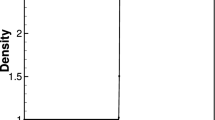Abstract
The convergence to steady state solutions of the Euler equations for the fifth-order weighted essentially non-oscillatory (WENO) finite difference scheme with the Lax–Friedrichs flux splitting [7, (1996) J. Comput. Phys. 126, 202–228.] is studied through systematic numerical tests. Numerical evidence indicates that this type of WENO scheme suffers from slight post-shock oscillations. Even though these oscillations are small in magnitude and do not affect the “essentially non-oscillatory” property of WENO schemes, they are indeed responsible for the numerical residue to hang at the truncation error level of the scheme instead of settling down to machine zero. We propose a new smoothness indicator for the WENO schemes in steady state calculations, which performs better near the steady shock region than the original smoothness indicator in [7, (1996) J. Comput. Phys. 126, 202–228.]. With our new smoothness indicator, the slight post-shock oscillations are either removed or significantly reduced and convergence is improved significantly. Numerical experiments show that the residue for the WENO scheme with this new smoothness indicator can converge to machine zero for one and two dimensional (2D) steady problems with strong shock waves when there are no shocks passing through the domain boundaries.
Similar content being viewed by others
References
Gottlieb S., Shu C.-W., Tadmor E. (2001). Strong stability preserving high order time discretization methods. SIAM Rev. 43:89–112
Harten A. (1983). High-resolution schemes for hyperbolic conservation laws. J. Comput. Phys. 49:357–393
Harten A., Engquist B., Osher S., Chakravarthy S. (1987). Uniformly high order essentially non-oscillatory schemes, III. J. Comput. Phys. 71:231–303
Henrick A.K., Aslam T.D., Powers J.M. (2005). Mapped weighted essentially non-oscillatory schemes: achieving optimal order near critical points. J. Comput. Phys. 207:542–567
Jameson A. (1993). Artificial diffusion, upwind biasing, limiters and their effect on accuracy and multigrid convergence in transonic and hypersonic flows. AIAA Paper 93–3359
Jameson A. (2001). A perspective on computational algorithms for aerodynamic analysis and design. Prog. Aerosp. Sci. 37:197–243
Jiang G.-S., Shu C.-W. (1996). Efficient implementation of weighted ENO schemes. J. Comput. Phys. 126:202–228
Jiang G.-S., Wu C.-C. (1999). A high-order WENO finite difference scheme for the equations of ideal magnetohydrodynamics. J. Comput. Phys. 150:561–594
Liu X.-D., Osher S., Chan T. (1994), Weighted essentially non-oscillatory schemes. J. Comput. Phys. 115:200–212
Osher S., Chakravarthy C. (1984). High-resolution schemes and the entropy condition. SIAM J. Numer. Anal. 21:955–984
Saad M.A. (1993). Compressible Fluid Flow. Prentice Hall, Englewood Cliffs, NJ
Serna S., Marquina A. (2004). Power ENO methods: a fifth-order accurate weighted power ENO method. J. Comput. Phys. 194:632–658
Shi J., Zhang Y.-T., Shu C.-W. (2003). Resolution of high-order WENO schemes for complicated flow structures. J. Comput. Phys. 186:690–696
Shu C.-W. (1988). Total-Variation-Diminishing time discretizations. SIAM J. Sci. Stat. Comput. 9:1073–1084
Shu, C.-W. (1998). Essentially non-oscillatory and weighted essentially non-oscillatory schemes for hyperbolic conservation laws. In B. Cockburn, C. Johnson, C.-W. Shu and E. Tadmor (Editor: A. Quarteroni), Advanced Numerical Approximation of Nonlinear Hyperbolic Equations Lecture Notes in Mathematics, Vol. 1697. Springer, Berlin, pp. 325–432.
Shu C.-W., Osher S. (1988). Efficient implementation of essentially non-oscillatory shock capturing schemes. J. Comput. Phys. 77:439–471
Shu C.-W., Osher S. (1989). Efficient implementation of essentially non- oscillatory shock capturing schemes II. J. Comput. Phys. 83:32–78
Van Leer B. (1979). Towards the ultimate conservative difference scheme. V. A second-order sequel to Godunov’s method. J. Comput. Phys. 32:101–136
Venkatakrishnan V. (1995). Convergence to steady state solutions of the Euler equations on unstructured grids with limiters. J. Comput. Phys. 118:120–130
Woodward P., Colella P. (1984). The numerical simulation of two-dimensional fluid flow with strong shocks. J. Comput. Phys. 54:115–173
Zhang, S., Zhang, Y.-T., and Shu, C.-W. (2005). Multistage interaction of a shock wave and a strong vortex. Phys. Fluid 17, 116101.
Zhang Y.-T., Shi J., Shu C.-W., Zhou Y. (2003). Numerical viscosity and resolution of high-order weighted essentially nonoscillatory schemes for compressible flows with high Reynolds numbers. Phys. Rev. E 68, 046709
Author information
Authors and Affiliations
Corresponding author
Additional information
Dedicated to the memory of Professor Xu-Dong Liu.
Rights and permissions
About this article
Cite this article
Zhang, S., Shu, CW. A New Smoothness Indicator for the WENO Schemes and Its Effect on the Convergence to Steady State Solutions. J Sci Comput 31, 273–305 (2007). https://doi.org/10.1007/s10915-006-9111-y
Published:
Issue Date:
DOI: https://doi.org/10.1007/s10915-006-9111-y




